AMD Announces Carrizo and Carrizo-L, Next Gen APUs for H1 2015
by Ian Cutress on November 20, 2014 5:45 PM EST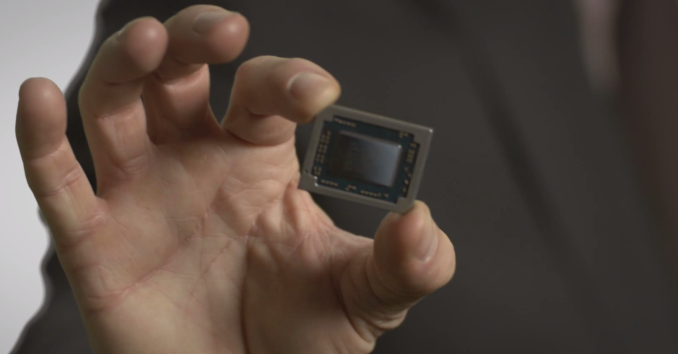
Today AMD is announcing the long anticipated upgrade to Kaveri, codenamed Carrizo. Carrizo is the natural successor to Kaveri, featuring x86 ‘Excavator’ cores alongside a Radeon-class GPU and promising an increase in performance all around. The second part of today’s announcement is for Carrizo-L, an SoC pairing “Puma+” (upgraded Beema) cores also with AMD’s R-series GCN GPUs and a FCH into a single package. Both Carrizo and Carrizo-L will feature ARM Trustzone, giving potential hardware-based built-in security when used by developers.
The Excavator cores are an architectural improvement over Steamroller, but are fundamentally based on the original Bulldozer concept. Excavator will be AMD’s fourth iteration of the concept, following Bulldozer, Piledriver and Steamroller. This new generation of APUs are still set to be built on the 28nm Super High Performance process at Global Foundries, delaying AMD’s shift to 20nm, but AMD are still claiming that the new GPU in Carrizo is their best yet, giving better performance and efficiency than before.
Given AMD's discrete GPU lineup, the GPU for Carrizo could be based on AMD's latest GCN 1.2 architecture, which was first introduced in the desktop Tonga part earlier this year. GCN 1.2's lossless delta color compression algorithms help improve the performance in memory bandwidth limited scenarios, such as in APUs. This could result in a bigger-than-expected jump in performance, although we will wait until we can test to find out how much it helps.
The Carrizo platform will be fully HSA 1.0 compliant, compared to Kaveri which only had ‘HSA Features’, as AMD puts it in their latest mobility roadmap update:
The push from AMD into HSA compliant APUs was well documented back at the launch of Kaveri earlier this year. This enabled the CPU and GPU components of the silicon, while under OpenCL 2.0 mode, to have access to the main block of system DRAM with zero-time copy functions, offering the potential for large classes of applications especially those in the prosumer and industry space to be accelerated by having instant access to the parallelization afforded by the GCN GPU. One of the big drawbacks of being an earlier adopter to HSA, as we noted at the time, was that software developers required time to bring their code to market, as well as AMD having to go out and teach the developers how to cater for HSA topology.
Both Carrizo and Carrizo-L on the mobile side will be targeted at the same power bands as Kaveri and Beema, although the socket will be new. The use of FP4 BGA also indicates that a single socket will cater for both the Excavator and Puma+ based APUs and would be interchangeable. A video by AMD’s VP/GM for Computing and Graphics, John Byrne, states that Carrizo and Carrizo-L are currently being tested internally ready for a 1H 2015 release, along with support for DirectX 12, OpenCL 2.0, Mantle and Freesync.
One of the big features that AMD is pushing with Carrizo is energy efficiency, with it being a keystone of the message. Because AMD have been on the same process node for a short while, they have to essentially follow the Maxwell example, by providing more performance for less power without the advantage of shrinking resistors. We were provided with an energy efficiency roadmap as well, showing the different methods AMD is using to achieve this:
One example of the efficiency improvement was provided by AMD’s Voltage Adaptive Operation. Rather than compensate for voltage variations which wastes energy, this technology takes the average operating voltage and detects when the voltage increases beyond a smaller margin. To compensate for this increase, the CPU speed is reduced until the voltage drops below the threshold and then the CPU speed is moved back up.
The changes in speed are designed to be so minute that it does not affect overall performance, however it might only take an errant voltage delivery component to consistently make the voltage go above that threshold, causing erratic slowdown that might be statistically significant. It will be interesting to see how AMD implements the latest version of this feature.
The 2015 desktop roadmap remains unpublished so far. AMD’s perception of a mobile-focused strategy would tend to suggest that the mobile comes first, with desktop following behind, although at this point it is unclear. A number of AMD’s marketing materials with this launch gave examples of the use of Carrizo and HSA for the prosumer, indicating that a desktop version should be announced in due course.
As of yet there was no discussion on the APUs to be launched, the speeds or the capabilities. All the roadmap tells us is 'up to four cores' (Excavator for Carrizo, Puma+ for Carrizo-L), some GCN compute units and 10-45W overall. There is no mention of DDR4 support, although the timeframe might be relevant for AMD to make the jump. Given the launch is still at least two quarters away, I would expect better details in due course. That timeframe fits in nicely around or just after Computex, perhaps indicating more details then.
Source: AMD


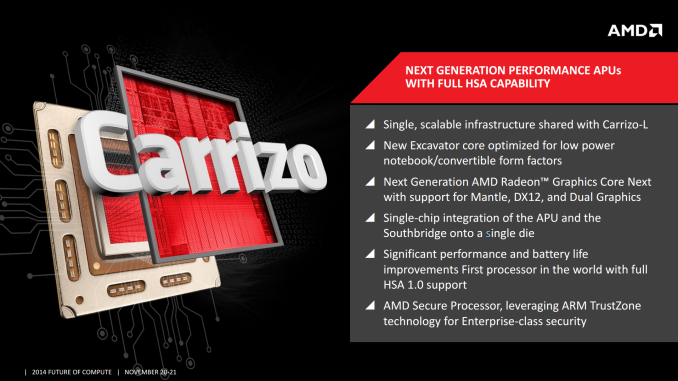
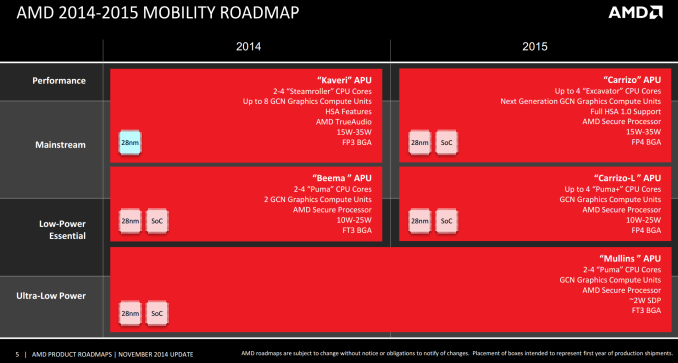
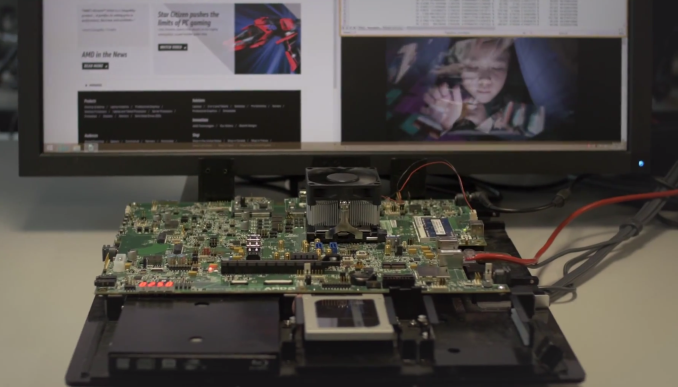
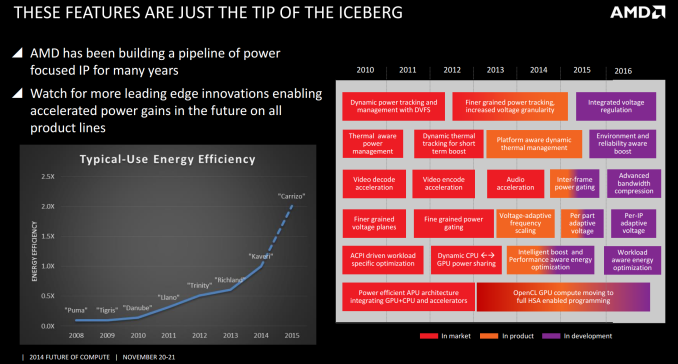
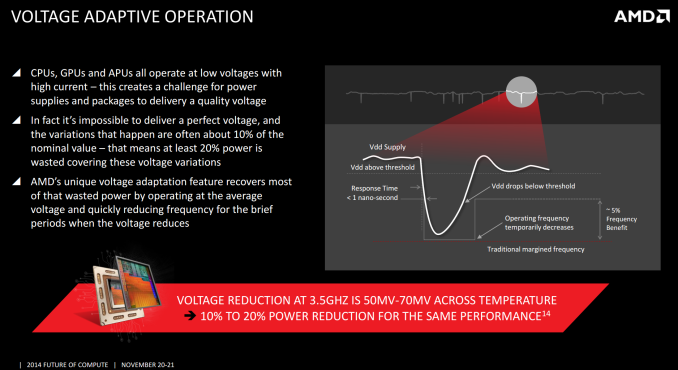
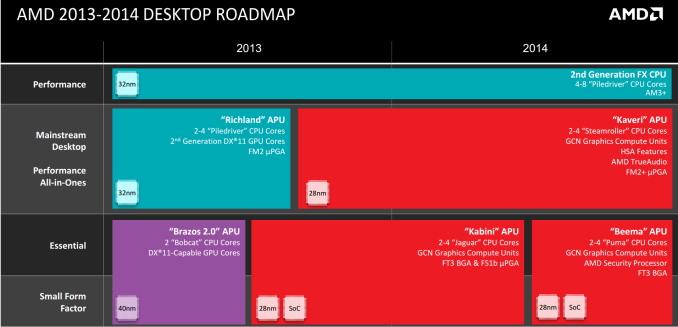








94 Comments
View All Comments
TiGr1982 - Friday, November 21, 2014 - link
I meant, specifically, Cinebench CPU score, especially single-threaded CPU score, which is a good indicator of CPU snappiness with respect to running simple serial software.umadrabbit - Sunday, December 14, 2014 - link
Cinebench single-threaded score is in no way an indicator of CPU snappiness. Where do You people even come up with this stuff? It just shows what the CPU is capable of doing in single-threaded workloads (which is starting to fade away anyway, more and more workloads keep going multi where AMD can still keep up with PD even on 32nm with slightly higher electricity bills)Death666Angel - Friday, November 21, 2014 - link
I read that the Retina laptops are/were bound by single threaded performance for their animation quality, which was why they dropped frames a lot. If that is still the case, I don't see an AMD future in them.MikeMurphy - Sunday, November 23, 2014 - link
Intel has vastly superior performance-per-watt. You won't find AMD chips in premium ultra thin mobile devices anytime soon.przemo_li - Friday, November 21, 2014 - link
Right now we have fully opensource HSA stack on Linux. This further indicate that AMD seriously think about getting part of Android pie (and HPC pie, which is Linux based).Of course Catalyst development on Win and userspace component on Lin is happening behind closed doors, so we do now know where its at HSA.
(Under Linux Catalyst will share kernel component with opensource driver, 285 will be first gpu with such driver stack)
Flunk - Friday, November 21, 2014 - link
At 28nm? Intel is already selling 22nm Atoms with 14nm chips showing up in a few months. On mobile, power consumption is a key value and the only way x86 can compete with ARM is with better processor optimization.Jumangi - Friday, November 21, 2014 - link
Man to look at the top of that desktop roadmap graphic and just seeing the never ending "2nd Gen FX" just go on and on makes me sad.Colin1497 - Friday, November 21, 2014 - link
Shrinking resistors?Also, your description of Voltage Adaptive Operation is the inverse of what the slide indicates. The slide indicates that they are compensating for dips, not increases. From the sound of it, historically they've had to clock as if they were operating at the dip voltage to prevent errors, but now that they are able to compensate, they can clock at the nominal voltage.
Colin1497 - Friday, November 21, 2014 - link
They are spinning this as being able to lower the nominal voltage and reduce power consumption, but it should also let the top parts clock higher.ant6n - Friday, November 21, 2014 - link
Who comes up with these brand names? They all sound like slow and heavy construction site equipment; and 'Carrizo' sounds like the workers' lunch sausage.